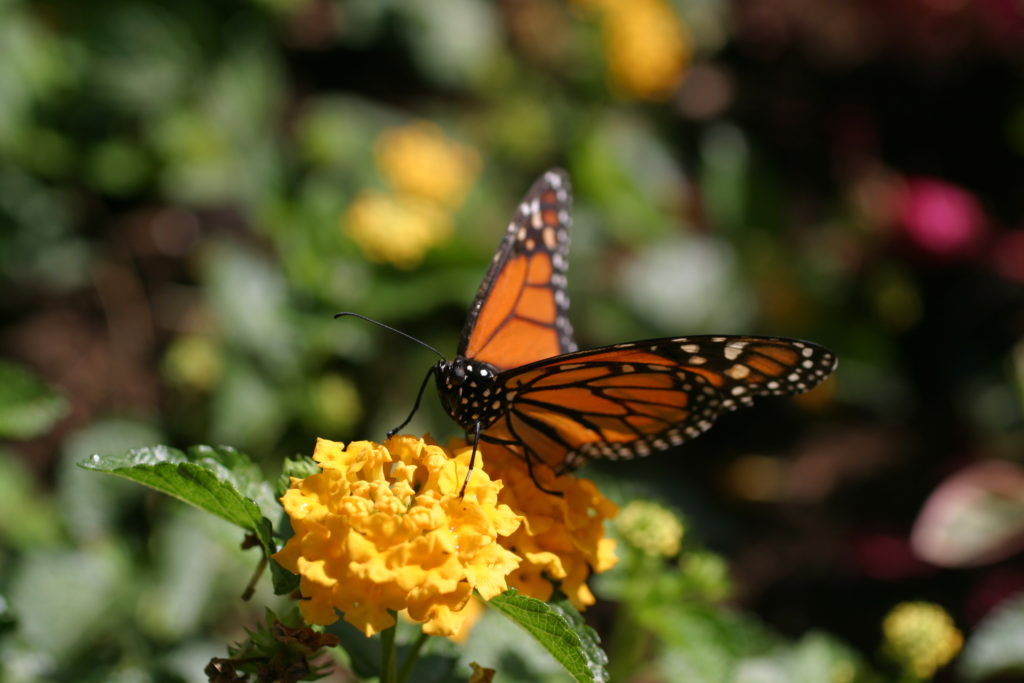Make Your Yard Friendly to Butterflies

2025 Spring Antiques Show | March 20 – April 6
2025 Fall Antiques Show | October 4 – 18

Butterflies are desirable additions to our landscapes. They are colorful and interesting. In South and Central Texas, we have a large number of butterfly species to enjoy. Our moderate climate allows some species to be active all year.
Nectar-producing Plants
As adults, butterflies feed by collecting nectar from blooming plants. The most obvious way to increase the variety and number of butterflies that visit gardens and the landscape is to offer nectar-producing blooms all year long.
Here is a list of plants, by calendar quarter, that will produce blooms to meet the needs of butterflies.

May, June, July
zinnia, plumbago, blue mistflower, milkweed, pavonia, cosmos
August, September, October
coneflower, vitex, penta, lantana, sunflower, mealy blue sage
November, December, January
fall aster, lavender, lantana, calendula, alyssum, dianthus
February, March, April
verbena, coreopsis, Salvia greggii, Fanick’s phlox, rain lily
Egg-laying Sites
Another way to increase butterfly numbers and diversity is to provide egg-laying sites.
For monarchs and queen butterflies, include one or more species of milkweed (Asclepias). The tropical milkweed has attractive orange or yellow flowers and is the easiest transplant to find, but there are several native milkweeds that are desirable. Plant native milkweeds if they are available, otherwise plant the tropical species. Milkweed has chemicals in its foliage that, when ingested by the butterflies, makes them taste bitter thereby discouraging predation. It’s ironic the most common native milkweed (Asclepias tuberosa), called “butterfly weed,” is the least chemically potent egg-laying site.
Citrus in the landscape provides an egg-laying site for giant swallowtails. The caterpillars look like bird droppings.
Dill and/or parsley, even if the plants are growing in containers, attract black swallowtails in search of an egg-laying site. Male black swallowtails are black, and the females are yellow.
Passion vine is a vigorous plant that produces showy blooms in several color choices. They are also known for being the favorite egg-laying site of Gulf fritillary butterflies. It’s not unusual for the feeding caterpillars to strip the vine nearly bare of foliage and leave the blooms on bare stems.
The “Gold Star” selection of Texas yellow bells is one of the best hot weather blooming plants in our area. The attractive and drought-tolerant plant is a favorite egg-laying site of the gray hair-streak butterfly.
Other favorite caterpillar food plants include: flame acanthus for Janais patch and Texas crescent spot butterflies; cudweed for the American painted lady butterfly; Ruellia species for Buckeye butterflies, and cannas for Brazilian skippers.
Limit Insecticide Use
The third strategy for increasing butterfly numbers in your landscape is adopting a reasonable insecticide policy.
Both organic and manufactured insecticides can kill butterflies.
by Calvin Finch, Ph.D.
Horticulturist
For more information and strategies for attracting butterflies, visit the Internet and the library. My favorite source of information is Butterfly Gardening for the South by Geyata Ajilvsgi.
2025 Spring Antiques Show | March 20 – April 6
2025 Fall Antiques Show | October 4 – 18